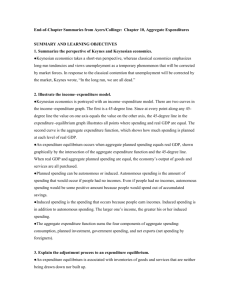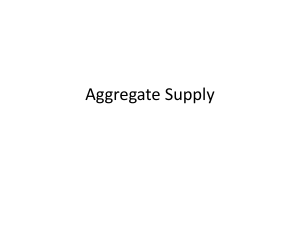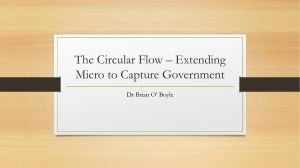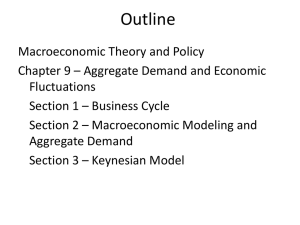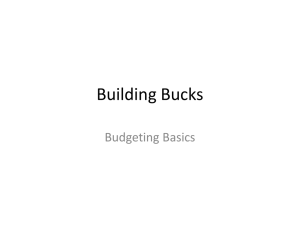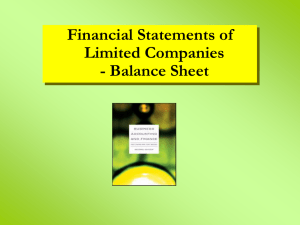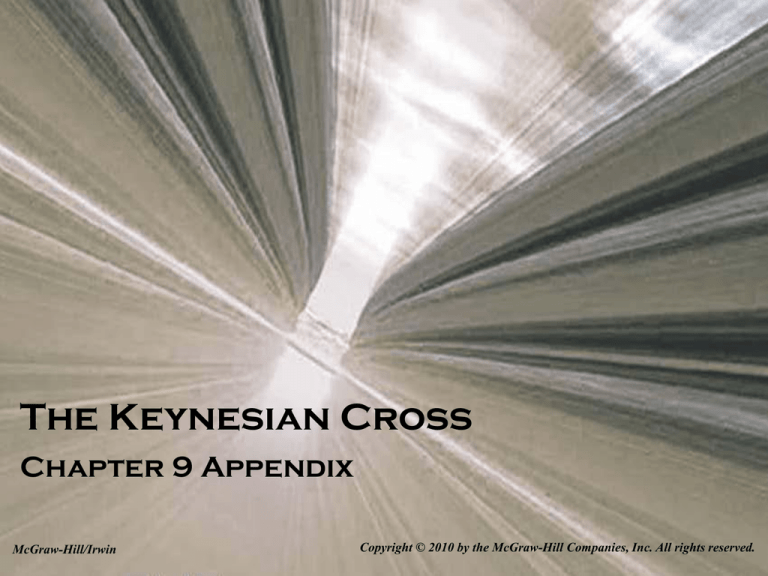
The Keynesian Cross
Chapter 9 Appendix
McGraw-Hill/Irwin
Copyright © 2010 by the McGraw-Hill Companies, Inc. All rights reserved.
The Keynesian Cross
• The Keynesian cross focuses on the
relationship of total spending to the value of
output, with no explicit distinction between
price levels and real output
• Aggregate expenditure: The rate of total
expenditure desired at alternative levels of
income, ceteris paribus
9A-2
The Consumption Shortfall
• Say the consumption function is:
C a bY D $100 0.75Y D
• With full employment output of $3 trillion,
consumption at full employment is
C F $100 0.75 $3, 000 billion $2, 350 billion
9A-3
The Consumption Shortfall
ZF
$3000
Expenditure
Total output
2350
CF
2000
Output not
purchased by
consumers
1500
1000
Consumption function
(C= $100 + 0.75YD)
500
YF
45°
0
1000
2000
3000
Income (Output)
9A-4
Non-consumer Spending
• Investors, governments, and net export buyers
add to consumer spending to equal aggregate
expenditure
• Aggregate expenditure still might not reach
full employment
9A-5
Aggregate Expenditure
At Income
(output) of
Consumers
Desire to
Spend
$ 500
$ 475
$ 150
$ 200
$ 50
$ 875
1,000
850
150
200
50
1,250
1,500
1,225
150
200
50
1,625
2,000
1,600
150
200
50
2,000
2,500
1,975
150
200
50
2,375
3,000
2,350
150
200
50
2,750
3,500
2,725
150
200
50
3,125
+
Investors
Desire to
Spend
+
Governments
Desire to
Spend
+
Net
Export
Spending
=
Aggregate
Expenditure
9A-6
Aggregate Expenditure
Y = AE
3500
YF
g
EXPENDITURE
3000
Aggregate expenditure
(AE = C + I + G + (X – M))
f
2500
e
2000
d
Consumer spending
(C= $100 + 0.75Y)
c
1500
b
1000
a
500
Investment spending = $150
Government spending = $200
$500
$1000
$1500
$2000
$2500
$3000
$3500
Net exports = $50
INCOME (OUTPUT)
9A-7
A Recessionary Gap
• In this case, we end up with less aggregate
expenditure ($2,750 billion) than the value of
full-employment output
• Recessionary gap: The amount by which
aggregate spending at full employment falls
short of full-employment output
9A-8
Recessionary Gap
$3500
Expenditure
Output at YF
3000
2750
2500
AE = Y
g
Recessionary gap
f
Equilibrium
2000
E
Desired
spending at YF
1500
1250
1000
500
45°
0
$500
Y1
1000
YE
1500
2000
YF
2500
3000
Income (Output)
9A-9
A Single Equilibrium
• Expenditure equilibrium: The rate of output
at which desired spending equals the value of
output
– The point where the AE and 45 degree lines meet
• Producers have no incentive to change the rate
of output, since are selling all they produce
9A-10
Expenditure Equilibrium
$3500
AE = Y
Expenditure
3000
2500
Equilibrium
2000
E
1500
1000
500
YE
45°
0
$500
1000
1500
2000
2500
3000
Income (Output)
9A-11
Expenditure Equilibrium
At Income
(output) of
Consumers
Desire to
Spend
$ 500
$ 475
$ 150
$ 200
$ 50
$ 875
1,000
850
150
200
50
1,250
1,500
1,225
150
200
50
1,625
2,000
1,600
150
200
50
2,000
2,500
1,975
150
200
50
2,375
3,000
2,350
150
200
50
2,750
3,500
2,725
150
200
50
3,125
+
Investors
Desire to
Spend
+
Governments
Desire to
Spend
+
Net
Export
Spending
=
Aggregate
Expenditure
9A-12
Macro Failure
• Market participants’ spending desires could
also exceed the economy’s full-employment
potential
• Inflationary gap: The amount by which
aggregate spending at full employment
exceeds full-employment output
9A-13
Two Paths to the Same Conclusion
• Both the Keynesian cross and the AD/AS
framework lead to the same conclusion about
macro instability
– The former focuses on total spending, the product
of output and prices
– The latter distinguishes separate effects of macro
instability on prices and real output
9A-14
The Keynesian Cross
End of Chapter 9 Appendix
McGraw-Hill/Irwin
Copyright © 2010 by the McGraw-Hill Companies, Inc. All rights reserved.


